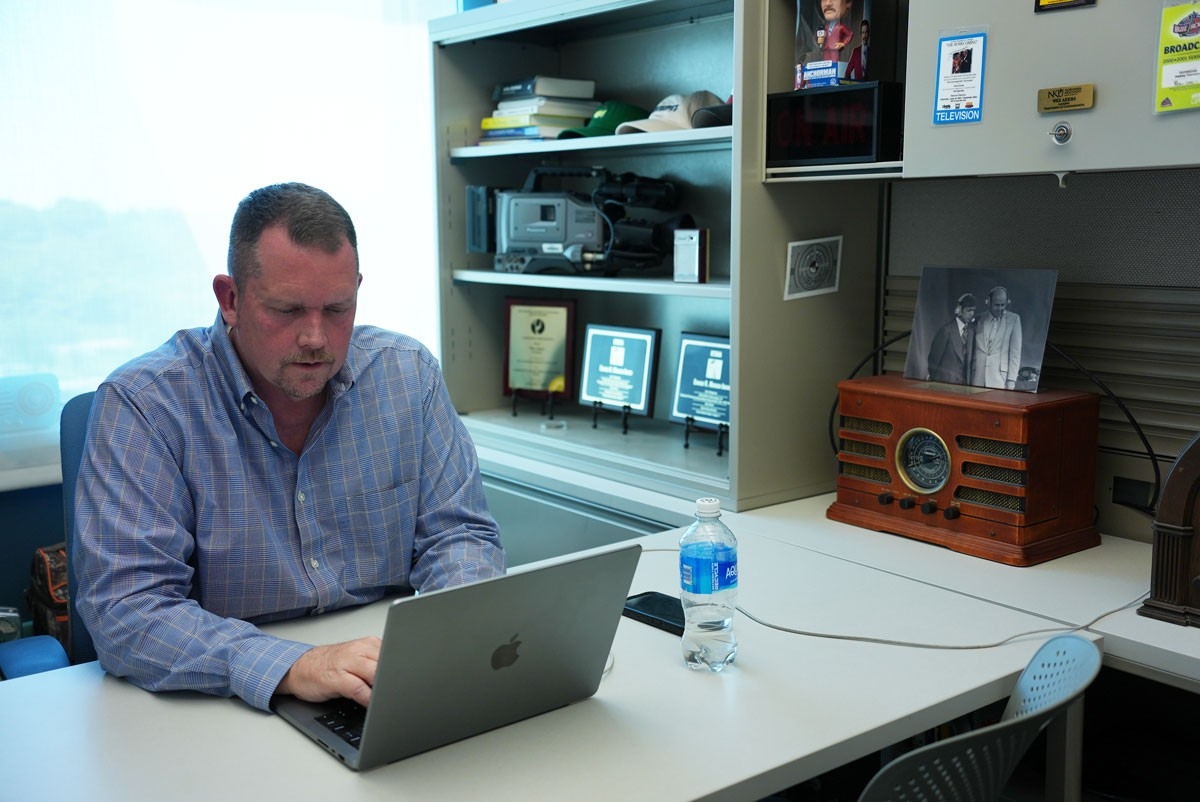
Photo by Grace Holland
Vintage radios and sports memorabilia dominate the décor in Wes Akers' office in Griffin Hall. So, it’s not surprising that a documentary about the history of sports radio was the electronic media and broadcasting teaching professor’s “dream” project.
“It’s like the history of broadcasting, the history of sports. That’s my thing,” he says.
The documentary, which premiered last September, is called “Archiving the Airways.” It centers on a vast collection of historic sports broadcasts owned and curated by Evansville, Indiana, resident John Miley, 93.
“I knew John had all these recordings of all these great regional announcers and the people he thought were great from the past, so it was incredibly thrilling for me to be able to actually hear these people and realize how good they were,” he says.
Last summer, Akers would go to his sister’s lake house near Dayton and stare out at the water and hit the play button.
“I would listen to all these clips as though they were actually on the radio at night,” he says. “I would just listen to the quality, the excitement and then try to figure out which ones am I going to use: ‘How am I going to piece all of this stuff together?’”
The moment he considers the “coolest, most magical thing ever” was listening to the St. Louis Cardinals play the New York Yankees when Joe DiMaggio was at bat and hit a line drive straight at Stan Musial. Akers had no idea what was going to happen, but he was picturing the play in his head as if it were happening in real time.
“Musial made a really nice catch on the play and it was just a nice Major League catch, just a simple out, but the fact those two players were involved and I felt like it was happening live in that moment, was like I was in a time machine,” he says.
To capture that same feeling for the documentary’s audience, Akers made use of those vintage radios in his office. The film shows equipment from different eras as the sound of broadcasts from the appropriate decade plays out. It’s as close to a real-world experience with these historic broadcasts as most documentary viewers will ever get.
While the audio clips include some other sports, the film focuses on baseball. Akers said one of the first things that occurred to him about Wiley, is that he holds every sports fan’s favorite summer in one room.
“Regardless of where you grew up, you had a radio and you followed your favorite team and that was your summer of ’63, that was your summer of ’51, that was your summer of ’42, that was your summer of ’76 or whatever it is,” Akers says.
Wiley was first introduced to Akers through Galen Clavio, the director of the National Sports Journalism Center at Indiana University Bloomington. The two met at a sports video conference and batted around ideas until Clavio mentioned Wiley as a possible subject.
Akers had a very short time to pull the project together. Wiley was donating his collection to the sports journalism center and a ceremony was planned for September, just two and a half months away.
“Every day was, like, I would go to bed around 2:30 a.m. and then get up at six,” Akers says.
But the more difficult part was selecting which clips to feature.
“One of the most exciting things is to have access to all this stuff. But one of the most challenging things is narrowing it down to 30 minutes,” Akers says.
He listened to hundreds of clips.
“I wanted to have a representation of as many regional announcers or significant games from different parts of the country,” he said. “I really like the emphasis on the regional announcers and that relationship with their fan base. I think that’s a really important part of sports broadcast history.”
Akers said he considers Wiley the true keeper of that history.
“His time span has really covered the development of broadcasting and of organized sports,” Akers says. “All three of those things have really paralleled each other. So, he, himself, is a treasure. I refer to him as a curator and he really is.”
Associate Professor of Practice, College of Informatics